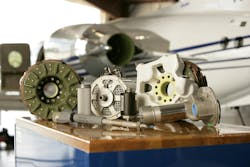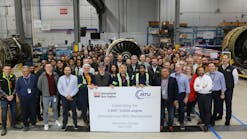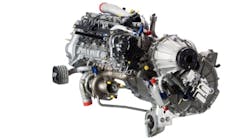There’s been a hunt for parts for years now in the industry. Supply chain strains, labor shortages and more continue to compound the problem. Just as the issues have dragged on, so too have they evolved over time. Now it’s not just a matter of finding parts, but verifying parts are safe and from trustworthy sources.
Matthew Fahrenkrog, procurement manager for Elliott Aviation, said five years ago he was spending less than 50 hours a week sourcing parts; today, he estimates he’s spending 80 to 100 hours a week.
Fahrenkrog’s sticking point is quality over price.
“These parts got to be good. I'm really not going to be all that interested in buying anything from any aftermarket or OEMs that have disappointed me in their quality of product. My number one item that I'm going to quote and present to the customer is somebody that has an established history with me of good quality products. In my opinion, that beats price,” he explained.
In fact, price is Fahrenkrog’s third concern, before that is availability.
“I can't have this airplane sit in my hangar floor for three months to save $100. Maybe another part was available for $100 more expensive,” he said. “So quality, availability, and then price.”
This new equation to the cost benefit analysis for parts purchasing skews what, perhaps, five years ago may have been the norm. For example, OEMs are most desirable for their quality despite a high price, but today are becoming the hardest to find – especially for legacy aircraft, Fahrenkrog said.
“Obviously, ordering from the OEMs is easy, right? It's usually more expensive, but easy. [But] they just don't support the models, especially some aircraft like Premiers and Hawkers that just aren't made anymore. They become forgotten sons, but there's still thousands of people out there flying them. It's forcing us to get smarter, and work harder, and source these parts as a PMA or aftermarket option,” said Fahrenkrog.
He estimates that 90% of the aircraft they service fall into the legacy category, exacerbating the difficulty and time it takes to search for and secure parts.
“They tend to stock parts like crazy for new aircraft that come off the line for about five years, but after about five years it just drops off,” he continued.
This has led Fahrenkrog to put more emphasis on PMA and aftermarket parts, but these are not always surefire options, and salvage parts are becoming a greater and greater resource.
“Salvage parts, over the last two or three years, especially since COVID, has blown up huge. The parts are just not available. So sometimes I don't even have the option to try aftermarket or to try PMA because they're not there either. So I would say the salvage parts end up being of my ‘Hail Mary’ effort,” he said.
Fahrenkrog said in a perfect world, he would prefer the OEM stock parts at a good price; second, he would choose some type of aftermarket or PMA at hopefully a cheaper price; leaving salvaged parts as a last-ditch effort. However, with the supply chain the way it is and availability being the prime factor often, Fahrenkrog’s left with little choice.
“[Salvage’s] probably the least desirable option, but sometimes I just don't have a choice,” he said.
Striking the Right Supplier Balance
Chris Kilgour, CEO of C&L Aviation Group, said when searching for the right supplier or distributor, he goes by what’s the best value for the money of an operator.
“Is it the OEM part or is it a PMA part, or some other way of doing things? So, once we've decided that, then we will go after whatever supplier we felt is the best option to serve our customers. Sometimes OEMs will approach us and other times we'll approach them because it makes sense,” he said.
Most customers nowadays will accept PMA parts, Kilgour noted, but there are still some that won’t.
“We need to look at that depending on what the part is. And then obviously, pricing, the best value for money. And really, just putting all those things together and deciding what makes sense. Sometimes it might be continuing supply, like this isn't a one-off, this is something that we want to stock all the time. So, who's able to supply us continuously over the next few years?” he continued.
Like Fahrenkrog, a lot of times it comes down to availability for C&L.
“We distribute for a lot of large OEMs, and I don't think it's any secret, they're having some major supply chain issues, whether it be because of raw materials, or labor, or whatever it might be, there's still a lot of challenges. It's got better, but there's still a lot of challenges out there,” Kilgour said.
This results in sometimes buying a part for a specific request , which often leads to buying from the closest supplier. But most of the time, C&L, when stocking items, will go wherever has the best value for money.
But Kilgour stresses – in today’s market, it’s important to really understand who the supplier is.
“We've been scammed a few times with people saying they've got parts and haven't got them. And if you're buying from someone new, they want payment in advance. So, we really have to be careful about going through a process to make sure that you know who they are and that they've got the part. And even then, you get caught sometimes. I think it's just something that goes with the territory, unfortunately,” he said.
Kilgour has encountered similar issues when calling around to places advertising they have parts only to discover they’re less than reputable.
“They're just wanting your call and they're trying to do broker sales,” he says. “It's almost like catfishing.”
To combat this, they rely on historical data and risk analysis when evaluating suppliers.
“We want to make sure they have current maintenance manuals, quality control manuals. We need to make sure they're ethical suppliers and their FAA mandated items are done,” he added. “I've been at this 20 years, Elliot's been around over 80 years. We got a ton of data. We know who's the good guys and who's full of smoke.”
Kilgour says to avoid scams and other issues is to maintain a constant dialogue with suppliers, OEMs, etc. and understand where they’re at, what they’re expecting, what issues they face and their timeframes for returning to normal.
“And if I'm going to buy a part, I want to see a picture of that part, I want to see a copy of the certification before I order it. And it's not 100% foolproof, but at least it does help to weed out those who are just saying they got the part,” he added.
A Return to Normal in 2024?
While many factors are at play in the aviation supply chain, Kilgour said he has seen some easement.
“It seems to me that it's been steady, getting slightly better. I haven't seen it get worse in the last six months or so. It is definitely on the getting better side of things, I think,” he said, and added that by the end of 2024, he anticipates most issues to be resolved.
Kilgour does think the industry needs to be careful about oversupply as the supply chain gets back to normal, however.
“If the OEMs start hitting their stride and start pumping out parts, I think it could be people have over-ordered, especially if they all come in at once and the demand doesn't seem to be there like it is, where people have ordered from multiple places for one requirement. So, that's what we've really been closely monitoring as things start to get better,” he said.
In the meantime, they’ve been rolling with the punches and coming up with creative solutions to parts scarcity.
“For instance, batteries has been another issue, but we've converted a lot of fleets over to the sealed LED acid battery instead of using the normal battery. And that's really helped out a lot of people. So, really just talking to people that know what they're talking about on the parts side, I think will help people to get through this period of difficulty with supply chain,” Kilgour explained.
Fahrenkrog added that one thing he thinks will help get things back to normal is a reduction in the automation that’s captured the industry since COVID.
“The customer has lost their voice, because the suppliers during COVID became so automated. We've lost that human connection, in my opinion. I think things used to be a lot easier. Like we used to have direct access,” he said.
He added that for much of his career, if the worst case scenario hit and he couldn’t find a part he was in desperate need of, he could get a direct contact on the phone, explain the situation, and be working toward fixing the dilemma with a parts supplier one-on-one. Now he finds he’s often dealing with call centers and people who either don’t know what he needs or don’t have the authority to get it to him.
“I think a lot of that can be cured if we go back to really focusing on these legacy models, and the legacy parts support, and then having that better, more direct human contact. When everything's automated, it's cold. You don't get your message across,” Kilgour said.
He worries that the industry may be turning what it needed to do to survive COVID into the new modus operandi instead of trying to reinforce itself against the next catastrophe.
“We need to make a better, more robust aviation supply chain and support system, not based on what we've done in the last few years,” he said. “That would be my desire. Let's not take it for granted and try to change our business models based on something we had to do in survival mode. Let's get back to thriving.”











